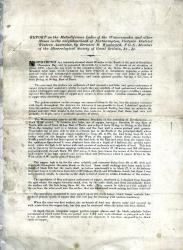
Report on the Metalliferous Lodes of the Wanerenooka and other Mines in the Neighbourhood of Northampton, Victoria District Western Australia. [With printed plan of a 'Portion of Wanerenooka Mining Property', signed and dated by Woodward.]
The report is printed on three pages of a bifolium with leaf dimensions roughly 30 x 21 cm. In small print. Both text and plan clear and complete. Both plan and map carry the faint 1 cm accession stamp of the Webster Collection, numbered in manuscript 4899. A scarce piece of Australiana, on grubby and stained paper, archivally repaired and tipped-in to cream paper folder. Describes the situation of the townships and mines, whose yields, both on the surface and at depth, he gives. Towards the end comments: 'It is unsatisfactory work reporting upon mines of which the shafts and workings are mostly filled with water so that they cannot be thoroughly investigated, but by examining the waste heaps and talking to the men who have worked in them in addition to making the observations I have recorded above, I am satisfied that the Wanerenooka is a most valuable property. The cause of the suspension of work in the district [...] was the great fall in the prices of lead and copper, [...]'. The plan is on one side of a 43 x 20.5 cm leaf, and is signed at the bottom 'Bernard H. Woodward | 25 Feby 1891'. At a scale of 20 chains to an inch, it divides the area north of the 'Northamptonshire Townsite' and Bowes River into rectangular numbered plots. The Wanerenooka Mine is, according to a report by the Heritage Council of Western Australia, 'the earliest mine in the Northampton area and the second copper mine in Western Australia', whose site 'contained the earliest European community in the Northampton area, forming the basis for later settlement throughout the region and the formation of the town.' No copy listed on COPAC or WoeldCat.


